Effective Strategies for Termite Control and Prevention


Intro
Termites, often considered a homeowner's worst nightmare, can silently wreak havoc on properties, leading to significant structural damage and costly repairs. Understanding how to spot these pests and implement effective control solutions is crucial for protecting your investment. This section dives into the essential aspects of pest identification, prevention methods, and do-it-yourself control tactics, blending practical advice with insights into the world of termites.
Pest Identification
Common Household Pests
While termites might steal the spotlight as notorious wood destroyers, they're not alone in the pest arena. In households, common pests include ants, cockroaches, and rodents. However, termites differ significantly in their anatomy and behavior. Most homeowners need to distinguish between drywood termites, which thrive in wood, and subterranean termites that dwell underground.
This awareness comes in handy when homeowners seek effective solutions tailored to specific pest threats.
Signs of Infestation
Identifying termites early can make all the difference. Here are some telltale signs:
- Mud tubes: These pencil-sized tubes act as highways for termites, linking their underground colonies to their food sources.
- Wood damage: Hollowed or paper-thin wood, often found in household structures, indicates a feeding frenzy. Knocking on wood surfaces may reveal dull thuds, suggesting internal damage.
- Swarmers: These are winged termites that leave their colonies to mate and establish new colonies, signaling a potential infestation.
Consumers should remain vigilant because these signs, if overlooked, can lead to severe consequences.
"An ounce of prevention is worth a pound of cure!"
Prevention Methods
Environmental Modifications
Creating an environment less hospitable to termites is paramount. Some effective modifications include:
- Managing moisture: Termites love damp spaces. Fix leaky pipes and ensure good drainage around your property.
- Clearing organic debris: Remove piles of mulch, leaves, and other organic matter close to the foundation of your home.
- Installing barriers: Consider installing physical barriers, like stainless steel mesh or sand barriers, during construction to deter termites.
Home Maintenance Tips
Regular home maintenance is not just about aesthetics; it's about pest management too. Consider these measures:
- Regular inspections: Schedule annual inspections with pest control professionals to pinpoint any potential threats before they spiral out of control.
- Sealing entry points: Check for cracks and crevices in walls, foundations, and window sills. Sealing these entry points can prevent termites from sneaking in.
- Proper ventilation: Ensure crawl spaces and attics are well-ventilated to decrease humidity levels, making your home less attractive to termites.
DIY Pest Control Solutions
Natural Remedies
If you're reluctant to call in professionals right away, some natural remedies can come in handy. For instance,
- Orange oil: Known for its active compound, d-limonene, orange oil can kill termites on contact. Just apply it directly in infested areas.
- Nematodes: These microscopic worms naturally prey on termites and can be bought at garden centers, providing a biological control option.
DIY Traps and Barriers
Creating your own traps and barriers is simpler than it sounds. Here's how:
- Cardboard traps: Place damp cardboard near infested areas, attracting termites. Once they settle in, dispose of the cardboard.
- Boric acid barrier: Mix boric acid with sugar to create a bait. Once ingested by termites, it disrupts their digestion, leading to death.
By getting hands-on, homeowners can take charge of their pest control strategy, making informed decisions that protect their homes effectively.
For further details about termite behavior and management, visit Wikipedia's termite page. Whether you're a housewife protecting your family's sanctuary or a homeowner committed to safeguarding your investment, understanding termite control solutions is a necessary step forward.
Prelude to Termites
Understanding termites is not just valuable for pest control; it’s essential for anyone who owns a property or spends time in wooden buildings. These small insects play a complex role in our ecosystems, contributing to nutrient recycling and soil health. However, their habits can be a double-edged sword when they turn their focus to our homes.
The importance of termites cannot be overstated. On one hand, they break down dead plant material, enriching the soil. On the other, they can cause significant structural damage if left unchecked. This section serves as an essential primer on termites, bringing awareness to their biological characteristics, the species that exist, and the potential threats they pose, making it a crucial aspect of effective termite control solutions.
The Role of Termites in Ecosystems
Termites are often misunderstood creatures. Rather than being mere nuisances, they are vital players in many ecosystems. They contribute to biodiversity and soil health by decomposing tough plant fibers, including cellulose found in wood. When termites digest this material, they produce waste that enriches the soil with nutrients. This process is critical for maintaining healthy ecosystems, especially in forested areas where dead wood often accumulates.
Moreover, by aerating the soil through their tunneling activities, termites enable better water absorption and root penetration, which benefits plants and, consequently, the entire food web that relies on these plants.
Common Termite Species
Termites can be divided into several species, each with unique traits and behaviors. Understanding these differences is key to effective prevention and treatment. The most common types are Subterranean Termites, Drywood Termites, and Dampwood Termites. Each type poses different risks and requires tailored approaches for management.
Subterranean Termites
Subterranean Termites are perhaps the most notorious of all termite types, particularly in the United States. They live underground in colonies and are known for their aggressive feeding habits. Their ability to create extensive tunnel systems allows them to reach wooden structures with ease.
What sets Subterranean Termites apart is their social behavior. They form large colonies that can number in the millions, making them efficient at quickly depleting wood resources. This rapid consumption can lead to dire structural damage if left unchecked. Their ability to survive and thrive underground, combined with their vast colonization, makes them a top consideration when discussing termite control methods.
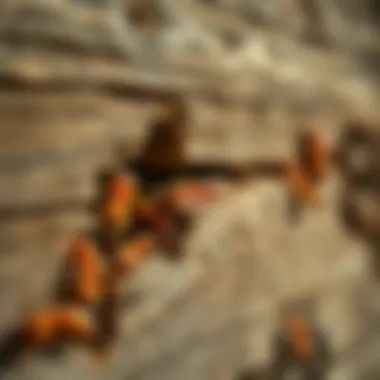
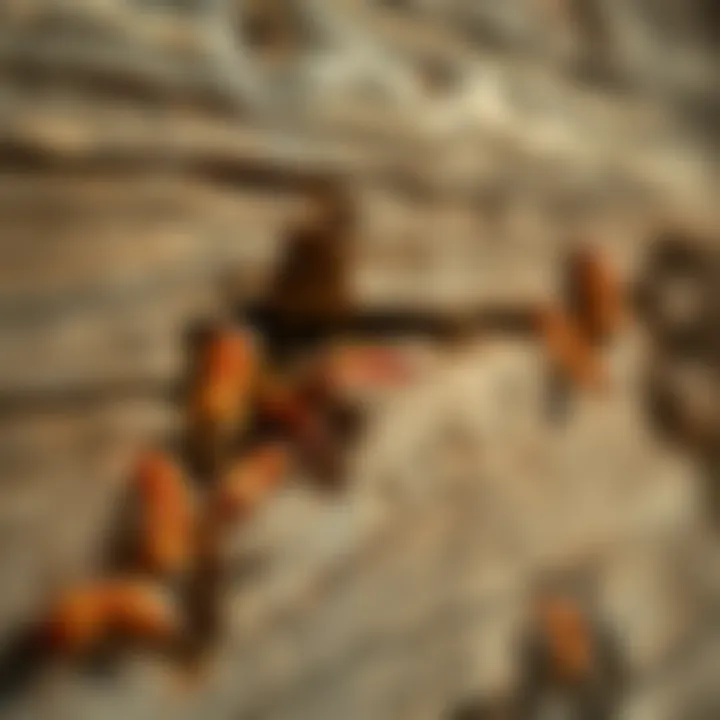
Drywood Termites
Drywood Termites, unlike their subterranean cousins, do not require contact with soil to thrive. They infest wooden structures, including furniture, and can be found in dry wood. Their more isolated colonies make them a little trickier to spot; however, they can cause similar damage over time.
A key characteristic of Drywood Termites is their ability to live entirely within the wood they infest, thus avoiding contact with the ground. This unique feature can present challenges for detection and treatment since infestations can go unnoticed for years. As they chew through wood, they leave behind frass, which can be a telltale sign of their presence.
Dampwood Termites
Dampwood Termites thrive in damp, decaying wood, making them a concern for properties in areas with high moisture levels. They often travel less and do not form large colonies like Subterranean Termites. However, their specific habitat requirements mean that they can still cause significant localized damage, particularly in timber and wooden structures near water sources.
These termites offer a fascinating case study in termite ecology. They exhibit different behaviors, like creating nests in decaying trees instead of entering human structures as other species do. While they typically pose less risk to homes in dry areas, property owners near moist environments should still be aware of their presence.
Understanding the different kinds of termites allows homeowners to choose targeted, effective control solutions.
Understanding Termite Behavior
Understanding termite behavior is pivotal when it comes to effective management and control. Knowing how these pests operate can empower homeowners and pest control professionals alike to make informed decisions. Termites are not simply nuisances; they play a complex role within their colonies that can directly affect how infestations manifest and how they can be treated. By grasping the intricacies of termite behavior, one can implement strategies that preemptively address issues rather than merely reacting to them.
Social Structure and Communication
Termite colonies are a marvel of nature, showcasing a complex social hierarchy. At the top, the queen and king oversee reproduction while worker termites handle foraging, nest maintenance, and brood care. Soldiers, on the other hand, protect the colony from threats. This division of labor is crucial for the survival of termites.
Termites communicate primarily through pheromones, chemical signals that convey various messages, including warnings about danger or the location of food. A single whiff of a specific pheromone can send the entire colony into action, leading them to mobilize for feeding or defense. Understanding this communication means a person can identify the best times to act against them, disrupting their routine and strategies effectively. For instance, applying baits during peak foraging times could enhance the likelihood of colony eradication by interrupting their usual food-gathering behavior.
Feeding Habits
Feeding habits of termites play a significant role in their destructive nature. While it’s commonly known that termites eat wood, their diet is a bit more varied. Termites primarily consume cellulose found in plant material. This includes not only wood but also dead grasses and leaf litter. Because wood makes up a large part of many homes, they can cause considerable damage.
Termites are either subterranean, drywood, or dampwood, and their feeding habits depend on their species:
- Subterranean termites prefer to nest underground and require moisture for survival. They typically find wood in contact with soil, digging tunnels that can travel significant distances.
- Drywood termites don’t need moisture from the ground and nest within the wood they consume. Their feeding can go unnoticed for years, leading to severe structural damage.
- Dampwood termites thrive in moist wood and often infest rotting trees.
Understanding these feeding habits helps in pinpointing potential points of entry for termite infestations and devising strategies for prevention. Homeowners can take preventative measures by ensuring wood is not in direct contact with soil, maintaining dry conditions, and performing regular inspections.
"Knowledge is power, especially when it comes to the silent destroyers in your home."
For more information, resources such as Wikipedia on Termites, or Britannica provide detailed studies on this subject.
Identifying Termite Infestations
Identifying termite infestations is a crucial step in managing and preventing long-term damage to your property. The sooner you can spot these pesky intruders, the better protected your home will be. Being able to recognize signs of infestation not only helps in taking early action but also saves homeowners from costly repairs down the line. Termites can quietly wreak havoc, so knowledge in spotting their presence and understanding inspection techniques is invaluable. This section will highlight the indicators of a termite presence, inspect critical methods—both manual and technological—for effective evaluation of your home’s status.
Signs of Termite Presence
The signs of termite presence may be subtle but are key to spotting an infestation before it spirals out of control. Here are some telltale signs to keep an eye on:
- Mud Tubes: These pencil-sized tubes, made of dirt and wood, serve as protective highways for termites. Check your home’s foundation and walls for these structures, especially in damp areas.
- Frass: This is termite droppings, resembling tiny pellets of wood particles or sawdust. If you find this near wooden structures or beams, termites might be munching away.
- Swarmers: During certain seasons, particularly in spring, you may notice termite swarmers—winged reproductive termites attempting to establish a new colony. If you see discarded wings, it may signal an active colony nearby.
- Damaged Wood: Knock on wooden surfaces. If they sound hollow, or if sections crumble easily, this suggests that the wood is being eaten away from the inside.
Spotting these signs early can make a significant difference in dealing with termites effectively.
Inspection Techniques
When it comes to discovering termites in your home, inspection techniques play a vital role. Two commonly employed methods include visual inspection and using advanced technology, each offering distinct approaches to identifying infestations.
Visual Inspection
Visual inspection remains the bread and butter of termite identification, and it’s accessible to everyone. This method involves a thorough examination of your home’s foundation, walls, and nooks and crannies where termites might dwell. One of the key characteristics of visual inspection is direct engagement; you can easily point out signs of damage or mud tubes.
The method is beneficial because it does not require specialized equipment, making it a cost-effective choice for homeowners. However, while thorough, this technique may have limitations, particularly in hard-to-reach spaces or within structural elements where termites hide undetected. What’s unique about visual inspection is its straightforward nature; it provides immediate insights into possible infestations, but it might miss the covert activity of termites in wall interiors.
Using Technology
Using technology for termite identification has made leaps in recent years, significantly enhancing detection capabilities. Technologies such as thermal imaging cameras and moisture meters have become popular tools in the pest control toolkit. The key characteristic of this approach is the ability to uncover signs of infestations without invasive methods, often finding what the naked eye might miss.
For instance, thermal imaging can reveal temperature variations along walls, exposing potential hidden colonies. Moisture meters can detect wood moisture levels, which could indicate current or previous termite activity. However, challenges exist; technology can be costly and might require professional training to interpret effectively. Despite the price tag, the unique advantage of technology is its precision, allowing for early detection that may save you thousands in the long run.
Both visual inspections and technology-supported evaluations have their strengths and limitations; therefore, employing a combination of techniques often yields the best results in identifying infestations.
"An ounce of prevention is worth a pound of cure. Early detection of termites can save you from significant costs and stress down the line."
By understanding these signs and inspection methods, homeowners can better protect their properties from potential termite invasions and the costly repairs that can follow.
Economic Impact of Termites
Understanding the economic impact of termites is crucial for homeowners and professionals involved in pest management. Termites can wreak havoc on structures, leading to considerable financial strain if not addressed efficiently. The repercussions extend beyond immediate repair costs; they can also affect market values and insurance premiums. Therefore, grasping the full extent of this impact is imperative.
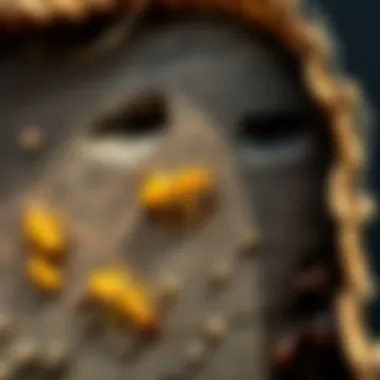

Structural Damage and Repair Costs
Termites are notorious for silently chewing through wood and other materials, slowly causing structural damage that often goes unnoticed until it’s too late. The actual costs for repairing termite-damaged structures can vary widely based on factors such as species involved, the extent of the infestation, and repair methods chosen.
- Signs of Damage: Homeowners may notice faint muddy tunnels in soil, or they might find hollowed-out wood. Common structural effects include sagging floors, cracks in walls, and visible wood damage.
- Repair Costs: The cost of repair can range dramatically. On average, a serious infestation can result in damages that run anywhere from a few hundred to over ten thousand dollars. Depending on the damage caused, this could involve replacing joists, beams, and drywall. In severe cases, entire sections of the house may need to be demolished and rebuilt.
Planning for these potential damages through regular inspections can serve as a financial buffer, especially in older homes or areas known for termites. It’s always better to prevent a problem than to fix it after the fact.
"Ignoring termite prevention is like leaving the back door open in a storm; you’re bound to face the consequences."
Insurance Considerations
When it comes to insurance, many homeowners might not realize that termite damage is often not covered. This can lead to significant out-of-pocket expenses if an infestation occurs. Understanding your policy and planning accordingly is essential.
- Policy Coverage: Standard homeowners insurance generally does not cover damage from pests, including termites. It’s vital to double-check with your insurance agent regarding what your policy includes or excludes in this area.
- Additional Riders: Some companies offer additional pest control endorsements. Homeowners might consider this as a way to protect against future damages. While it may involve added premium costs, the potential savings during a termite-related crisis could outweigh the initial expense.
- Regular Inspection Discounts: Some insurance companies provide discounts for homes that go through regular pest inspections. Keeping documentation of these inspections can be beneficial not only for insurance purposes but also for home resale value.
Proven Methods of Termite Control
Understanding the various strategies for termite control is crucial for anyone looking to safeguard their property from damage. The financial burden of infestation can be substantial; thus, adopting proven methods is more than just a precaution—it's a necessity. Effective termite control not only protects your home but also contributes to the overall health of the environment by minimizing the use of harmful chemicals. The methods we'll discuss here are widely recognized for their efficacy: chemical treatments, physical barriers, and biological or organic methods. Each approach offers unique benefits, and understanding these can empower homeowners to make informed decisions.
Chemical Treatments
Chemical treatments remain a frontrunner in the battle against termites. They effectively eliminate existing infestations and protect structures from future attacks. When discussing chemical treatments, two popular categories emerge—liquid termiticides and baiting systems.
Liquid Termiticides
Liquid termiticides are a powerhouse in termite control strategies. They work by creating a persistent barrier around the foundation of a property, preventing termites from entering. One key characteristic of liquid termiticides is their long-lasting effectiveness, which can last for several years when applied properly. This makes them a solid choice for homeowners seeking both immediate and enduring protection.
The unique feature that stands out in liquid termiticides is their ability to penetrate the soil, allowing them to reach and eliminate hidden termite colonies. However, homeowners should be aware of the disadvantages as well; some liquid treatments can be harmful to beneficial insects and may have environmental impacts. Despite this, when applied with care and under professional guidance, liquid termiticides can be an efficient solution in the fight against termites.
Baiting Systems
Baiting systems are another effective chemical treatment, distinguished by their method of operation. Instead of creating a barrier, baiting systems lure termites to a bait station that contains a slow-acting insecticide. This allows termites to consume the bait and carry it back to their colony, ultimately leading to the demise of the entire colony. The appeal of baiting systems lies in their subtlety; they target termites without requiring extensive disruption to the surrounding environment.
One significant advantage of baiting systems is their ability to monitor termite activity. This can be particularly useful for preventive measures, as homeowners can adjust their strategies based on real-time data. On the flip side, baiting systems require regular monitoring and maintenance, which some may find cumbersome. Nevertheless, they offer a reliable method for those wanting to control termite populations sustainably.
Physical Barriers
Physical barriers are essential in termite prevention and are often implemented during the construction phase of a home. These barriers may include metal mesh, concrete, or treated wood, which deter termite entry effectively. The idea is straightforward; by halting termites at their point of entry, homeowners can save on costly pest control expenses down the road.
An added benefit of physical barriers is that they contribute to the overall sustainability of your home. Unlike chemical treatments, they don't pose risks to the environment and require minimal upkeep. However, it’s worth noting that once installed, physical barriers cannot be easily adjusted or repaired. Homeowners should work closely with professionals during the construction phase to ensure the barriers are implemented effectively.
Biological and Organic Methods
As environmental awareness grows, biological and organic methods are coming to the forefront in termite management. These methods include the use of beneficial nematodes or fungi that naturally target and kill termites. One of the most compelling aspects of these biological methods is their minimal environmental impact; they work in harmony with nature rather than against it.
The unique features of biological methods are their safety and effectiveness. Homeowners can utilize them in tandem with other strategies for a more holistic approach. However, like many natural solutions, their effectiveness may vary depending on the specific circumstances and severity of the infestation.
Sustainable Practices in Termite Management
Sustainable practices in termite management play a vital role in fostering long-term solutions that are both ecologically sound and effective. In a world increasingly aware of environmental concerns, homeowners are looking for methods of termite control that minimize chemical usage while still delivering results. Sustainable practices not only help in managing termite populations but also contribute towards the overall health of the ecosystem.
The adoption of sustainable termite management approaches can yield numerous benefits. First, integrated pest management (IPM) promotes a holistic understanding of pest dynamics that allows for targeted interventions. Rather than relying solely on chemical solutions, IPM emphasizes the control of pest populations through a combination of biological, cultural, and physical methods. This creates a more balanced approach, lessening the potential negative impact on non-target species and the broader environment.
Moreover, sustainable practices encourage informed decision-making. Homeowners who engage in regular inspections, understand the signs of infestations, and learn about the biology of termites are in a stronger position to prevent severe infestations. This proactive stance often involves minor adjustments around the home, like maintaining proper drainage or reducing wood-to-soil contact, which can greatly reduce the likelihood of infestations down the line.
Another crucial aspect of sustainable practices is the consideration of natural predators. These are species that thrive on termites and help naturally regulate their populations. By fostering a diverse ecosystem, homeowners can turn their yards into a fortress against termites while promoting biodiversity. Utilizing such methods can be rewarding not just in terms of pest control but also in cultivating a healthy landscape which benefits all types of wildlife.
Professional Pest Control Services
Professional pest control services stand as a crucial pillar in the fight against termite infestations. With the alarming rise of termite-related damage to properties, the role of experienced pest controllers has never been more significant. They bring expert insight into what often appears an overwhelming issue for many homeowners. However, it’s not just about eradicating the pests; these services offer a tailored approach to both prevention and control, making them invaluable in a homeowner's toolkit.
When to Seek Professional Help
Knowing when to call in the professionals can save a property from irreversible damage. Here are some signs that may indicate the need for expert intervention:
- Visible Signs of Infestation: If you notice mud tubes, frass (termite droppings), or hollow-sounding wood, it’s time to take action.
- Unexpected Structural Issues: If doors or windows suddenly jam, it may hint at termite activity.
- Previous Infestations: A history of termite issues in your vicinty can make your property more susceptible, warranting regular check-ups from pest control experts.
- DIY Methods Failing: If you’ve attempted your own solutions with little success, it may be a signal that a professional's expertise is needed.
Choosing a Pest Control Service
Choosing the right pest control service is pivotal for effective treatment and long-lasting results. The following considerations can help you make an informed decision:
Evaluating Credentials
Evaluating the credentials of a pest control service is an essential first step. Licensing and certification indicate that the company adheres to industry standards and regulations. This brings peace of mind to a homeowner.
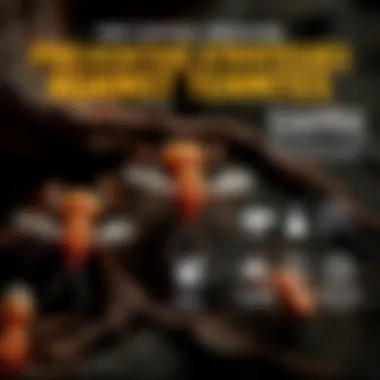
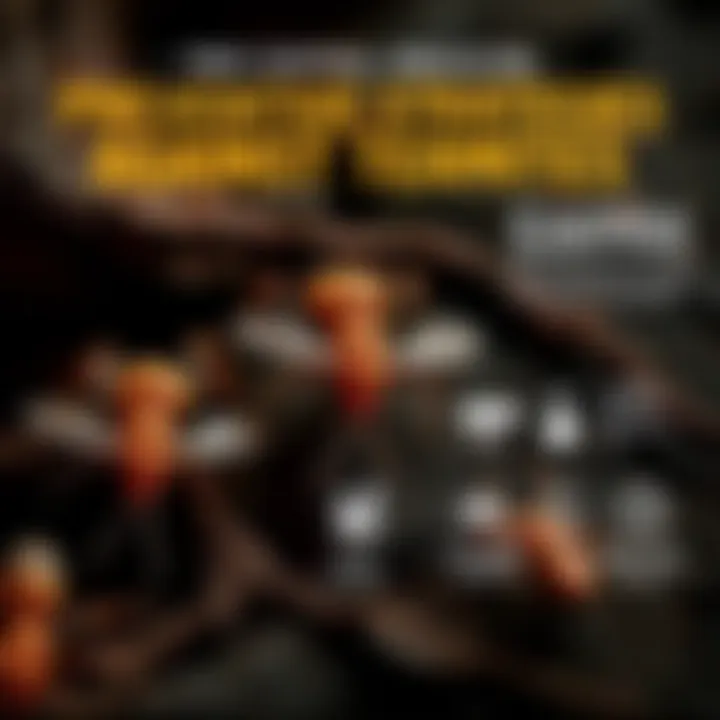
A key characteristic here is that licensed professionals need to undergo rigorous training which helps ensure a higher success rate in treatments. Additionally, companies with affiliations to national or local pest control associations often have backing from the industry, solidifying their reliability.
In this regard, obtaining references or reading reviews can also provide insight into a service's effectiveness. However, keep in mind that affiliation alone is not a guarantee of quality; evaluating customer feedback remains critical in selecting a service.
Understanding Treatment Plans
Understanding treatment plans offered by pest control services is equally important. A well-laid plan should include details on the methods that will be used, along with timelines and follow-up measures.
A significant part of understanding these plans involves knowing the pest control methods’ potential impacts on your environment and structure. Some services might offer eco-friendly treatments as alternatives to traditional chemicals, an essential factor for homeowners concerned about health and safety.
Unique features of treatment plans should also be taken into consideration. For instance, a plan that includes regular follow-ups and monitoring can provide added assurance against future infestations. While initial costs might seem higher for comprehensive plans, they often prove more economical in the long run due to enhanced effectiveness and prevention measures.
Preventive Measures for Termite Control
Preventing termite infestations is not just a smart move; it’s vital for protecting your property from potential damage. The cost of repairs after termite damage can be staggering, running into thousands of dollars. By implementing preventive measures, homeowners and caretakers can mitigate the risks associated with these pests, ensuring peace of mind. These measures create a multi-faceted approach that addresses both the physical and environmental factors contributing to termite infestations.
Home Design Considerations
When it comes to safeguarding your home against termites, design plays a crucial role. Certain architectural features can either hinder or facilitate termite entry and activity.
- Foundation Type: A well-constructed foundation can act as a barrier. Concrete slabs, for instance, are less inviting to termites compared to wooden structures. Homeowners should consider using materials that are less susceptible to pest infiltration, such as steel framing.
- Ventilation: Proper ventilation in crawl spaces and attics reduces moisture levels—something termites thrive on. Install vents to allow airflow, and consider using fans to enhance circulation where it’s needed most.
- Drainage: Ensuring that all drainage systems are directed away from the foundation is crucial. Poor drainage can lead to standing water, providing the perfect habitat for termites to flourish. Downspouts and gutters should be maintained regularly to prevent blockages.
- Landscaping: Be cautious with mulch and landscaping choices. Termites love wood, so using alternatives like stones or rubber mulch can help prevent them from being attracted to your home. Keep plants trimmed and away from wooden structures to lessen the risk further.
Taking these design considerations to heart can significantly enhance your home’s defense against termites, often beginning before a single wall is erected.
Regular Maintenance Practices
Regular upkeep of your home is essential—not just for aesthetics, but also for a termite-free environment. Here are some maintenance practices worth adopting:
- Routine Inspections: Scheduling annual pest inspections will help catch potential problems early. An expert can identify early signs of termite activity or conducive conditions.
- Moisture Control: Check for leaks in plumbing and the roof. Fixing leaks promptly will minimize moisture accumulation, deterring termites from gathering.
- Wood Treatment: Applying insecticides to any exposed wood can protect against future infestations. These treatments can provide a long-lasting barrier.
- Seal Vulnerabilities: Periodically check for gaps in windows, doors, and foundations, and use caulk or sealant to close any openings that could serve as entry points for termites.
- Firewood Management: Store firewood away from the house and elevate it off the ground. This reduces the likelihood of wood pests making your house their home.
Incorporating regular maintenance practices helps create a proactive defense against termites, making it less likely you’ll face a costly infestation down the road.
"An ounce of prevention is worth a pound of cure." - Benjamin Franklin
By prioritizing preventive measures in home design and maintenance, homeowners can navigate the challenges posed by termites effectively. Not only do these actions save money, but they also create a safe and secure living environment.
Future Trends in Termite Research
The exploration of termite behavior and control is far from stagnant. As pest management technology advances, the study of termites is evolving, offering promising avenues for effective control solutions. Understanding these future trends is crucial not just for pest control professionals but also for homeowners who want to protect their property investments. Anticipating how research unfolds can lead to more informed decisions regarding prevention and treatment methods.
Advancements in Treatment Methods
The quest for more effective termite treatments is perpetual. Researchers are investigating novel compounds and refined application techniques that promise better efficacy and reduced environmental impact. These advancements include:
- Targeted Chemical Innovations: New synthetic compounds can be formulated that disrupt termite communication or reproduction, limiting their ability to infest structures.
- Nanotechnology: Utilizing nanomaterials might enhance the delivery of active ingredients in treatments. This means that lower quantities of chemicals could achieve the same results, minimizing toxicity and environmental concerns.
- Smart Bait Systems: Incorporation of technology in bait systems allows for real-time monitoring and rapid response to any uptick in activity, making treatment more effective and less invasive.
These innovations are important as they not only improve efficacy but also align better with sustainability standards. They help ensure a safer environment for both homeowners and pest control technicians.
Research on Termite Behavior
Understanding termite behavior is key to controlling their populations effectively. Studies are diving into aspects such as social dynamics and foraging patterns. Some areas of interest include:
- Queen Control: Exploring how the removal or disruption of a queen influences colony behavior could lead to effective strategies for eradicating colonies.
- Foraging Algorithms: By studying how termites search for food, researchers seek to develop more efficient bait placement strategies. This could lead homeowners to make treatment decisions that are more precise and impactful.
- Behavioral Disruption: Researchers are investigating methods to disrupt communication between termites. If they can impede their pheromone trails, it may drastically reduce their ability to navigate and establish new colonies.
In essence, these lines of research underscore the complex world of termites and how a deeper understanding can transform control methods. Such insights pave the way for creating tailored strategies that can significantly improve efficiency in termite management.
The continuous research around termite behavior not only enhances our control options but also contributes to a more sustainable approach in pest management.
By staying informed about these trends, homeowners can take proactive measures in termite prevention and treatment, ultimately safeguarding their investments and ensuring peace of mind.
Ending and Key Takeaways
The exploration of termite control solutions reveals a complex landscape filled with myriad strategies, technologies, and practices. Each method plays a crucial role in the effective management of termite infestations. Understanding these strategies allows homeowners and pest control professionals to make informed decisions based on specific situations and environments.
Recap of Proven Strategies
In summation, the proven strategies for termite control include:
- Chemical Treatments: Utilizing liquid termiticides and baiting systems, these methods are designed to eliminate existing colonies and prevent future invasions.
- Physical Barriers: Installation of barriers during construction can effectively prevent termites from accessing wooden structures. This includes plastic sheeting and steel mesh.
- Biological and Organic Methods: Employing natural predators and organic substances proves effective in managing termite populations without harmful chemicals.
- Integrated Pest Management (IPM): Combining multiple control methods tailored to the specific needs of the home is a holistic approach to termite management.
Adopting a mixed-method approach often yields the best results in keeping these pests at bay.
Recognizing the signs of termite presence and remaining vigilant with regular inspections helps homeowners spot potential issues before they escalate. Each of these strategies not only combats termites but also fosters a deeper understanding of their behavior and habitats, enhancing overall prevention efforts.
Importance of Ongoing Education in Pest Management
Pest management is not a one-and-done endeavor. Staying updated about the latest research, advancements, and methodologies is essential. Continued education in pest management helps individuals understand:
- New Products and Techniques: As science evolves, so do the tools used for termite control. Knowing the latest products can lead to more efficient and effective treatments.
- Behavioral Insights: Learning more about termite behaviors and their environments allows for better planning and prevention strategies.
- Sustainable Practices: Awareness of eco-friendly approaches ensures that pest control methods align with a homeowner’s values while still being effective.
Participating in workshops, reading industry publications, and engaging with pest control professionals can all contribute to a homeowner’s skill set. This proactive approach empowers individuals to manage termite issues more effectively, saving time and costs associated with severe infestations. Keeping education at the forefront of pest management practices not only protects properties but also bolsters long-term solutions in the fight against termites.















